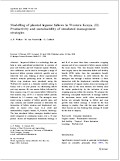| Journal Article |
 |
|
| Article Title | Modelling of planted legume fallows in Western Kenya. (II) Productivity and sustainability of simulated management strategies | | Author | A.P. Walker, Meine van Noordwijk and Georg Cadisch | | Year | 2008 | | Journal Title | Agroforest Syst | | Institution | Springer Science+Business Media B.V. 2008 | | Volume | 2008 | | Issue | 74 | | Pages | 143–154 | | Call Number | JA0292-08 | | Keywords | Computer simulation, Organic matter, Pedotransfer functions, Soil fertility, Tropical, Water limitation, Leaching, WaNuLCAS |
|
| Abstract: |
| Improved fallow is a technology that can help to raise agricultural productivity in systems of poor soil fertility and low financial capital. Models, once calibrated, can be used to investigate a range of improved fallow systems relatively quickly and at
relatively low cost, helping to direct experimental research towards promising areas of interest. Six fallow crop rotations were simulated using the WaNuLCAS model in a bimodal rainfall setting in Kenya over a 10 year period: (A) alternating fallow
and crop seasons, (B) one season fallow followed by three seasons crop, © one season fallow followed by four seasons crop, (D–F) 1–3 seasons fallow periods followed by 3–5 seasons crop. The strategies were tested using a number of fallow growth rates, soil
clay contents, and rainfall amounts to determine the interaction of fallow rotation and biophysical variables on maize (Zea mays (L.)) yield and sustainability (organic matter, N2 fixation, leaching). The best simulated fallow strategies doubled maize yield compared to continuous maize over a 10 year period. Across all biophysical treatments strategy A and B of no more than three consecutive cropping seasons and of one consecutive fallow season yielded the most maize. This was because fallow benefits
were largely due to the immediate fallow soil fertility benefit (IFB) rather than the cumulative benefit (CFB). The difference in yield between the two strategies was through a balance between (1) their interaction with the biophysical variables affecting
accumulation of organic matter, hence increasing soil fertility and (2) the extra intrinsic soil fertility used for maize productivity by the inclusion of more cropping seasons within the rotation. We propose the following conceptual framework to manage fallows
for maximum maize yield: when environmental factors are strongly limiting to fallow and crop growth then fallow strategy A would be the best strategy to employ (less risk but more labour) and when factors are less limiting then strategy B would be the best to employ. |
|
|
Download file(s): Click icon to download/open file.
|
| |
File Size |
Description |

|
- |
URL |
|
|
GRP 1: Domestication, utilization andconservation ofsuperior agroforestry germplasm
|
| Viewed in 2200 times. Downloaded in 718 times. |